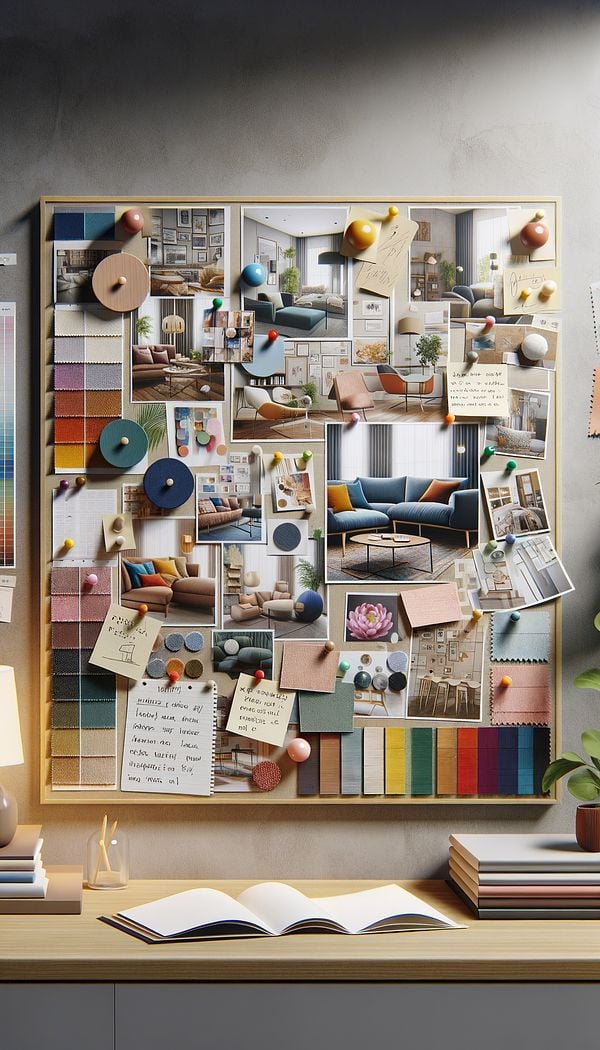What is a Mood Board?
A mood board is a visual tool that conveys the overall 'feel' or concept of a design project.
Description
A mood board is an essential tool in the arsenal of interior design, encapsulating not just the look, but more importantly, the 'feel' or atmosphere that a project aspires to achieve. It's a collection of images, color swatches, patterns, textures, and sometimes objects, that serve as the visual representation of a design concept. Mood boards allow designers to communicate their ideas and vision effectively to clients, collaborators, and stakeholders, ensuring that everyone involved has a shared understanding of the design direction.
Creating a mood board involves selecting elements that reflect the desired ambiance of the space. This could range from serene and calm for a bedroom to energetic and vibrant for a creative office space. In addition to visuals, mood boards can also include notes or keywords that further articulate the conceptual direction. The process encourages exploration and experimentation, enabling designers to mix and match ideas until they arrive at a cohesive concept.
Once a mood board is finalized, it serves as a guide throughout the design process, informing decisions on furniture types, wall treatments and finishes, flooring and carpets, and even smaller details like lighting fixtures and decorative objects. The board ensures consistency in the design aesthetic and helps to keep the project aligned with the initial vision.
Usage
For instance, when designing a boutique hotel, an interior designer might create a mood board that combines photographs of vintage furniture, fabric samples with bold patterns, and color palettes inspired by Art Deco to capture the essence of the era and set the direction for the design. Similarly, in a residential project aiming for a minimalist and eco-friendly aesthetic, the mood board could feature natural materials, simple lines, and a muted color scheme.
FAQs
-
Do mood boards have to be physical?
No, mood boards can be both physical and digital. Digital mood boards are particularly popular for their convenience and ease of sharing, though some designers prefer the tactile experience of creating physical boards.
-
Can mood boards include 3D elements?
Yes, mood boards can include three-dimensional elements such as fabric swatches, small objects, or material samples to add depth and texture, giving a more comprehensive sense of the space.
-
How often should the mood board be referred to during the design process?
The mood board should be referenced regularly throughout the design process to ensure that every choice, from the largest furniture piece to the smallest decorative detail, aligns with the initial concept and desired atmosphere.
Practical Application
When starting on a new design project, gather inspiration from various sources - magazines, online platforms, nature, and even fashion. Keep an open mind during the collection phase and select elements that resonate with the project’s vision. Use software tools or physical boards to assemble your ideas, arranging and rearranging until the board communicates the intended mood effectively. Regularly referring back to your mood board during the project will help maintain cohesiveness in your design decisions.
-
Design Styles478 articles
-
Decorative Techniques322 articles
-
Decorating Principles & Elements330 articles
-
Color & Patterns154 articles
-
Wall Treatments & Finishes157 articles
-
DecoratorIn interior design, a decorator focuses on enhancing the aesthetic appearance of a space.
-
TriptychA triptych is an art installation consisting of three panels or pieces meant to be displayed together.
-
CasingCasing is a type of trim used around doors and windows to cover the gap between the wall and the frame.
-
CofferA coffer is a sunken panel in a ceiling or dome.
-
AfghanIn interior design, 'afghan' typically refers to a handcrafted blanket or throw, often knitted or crocheted.
